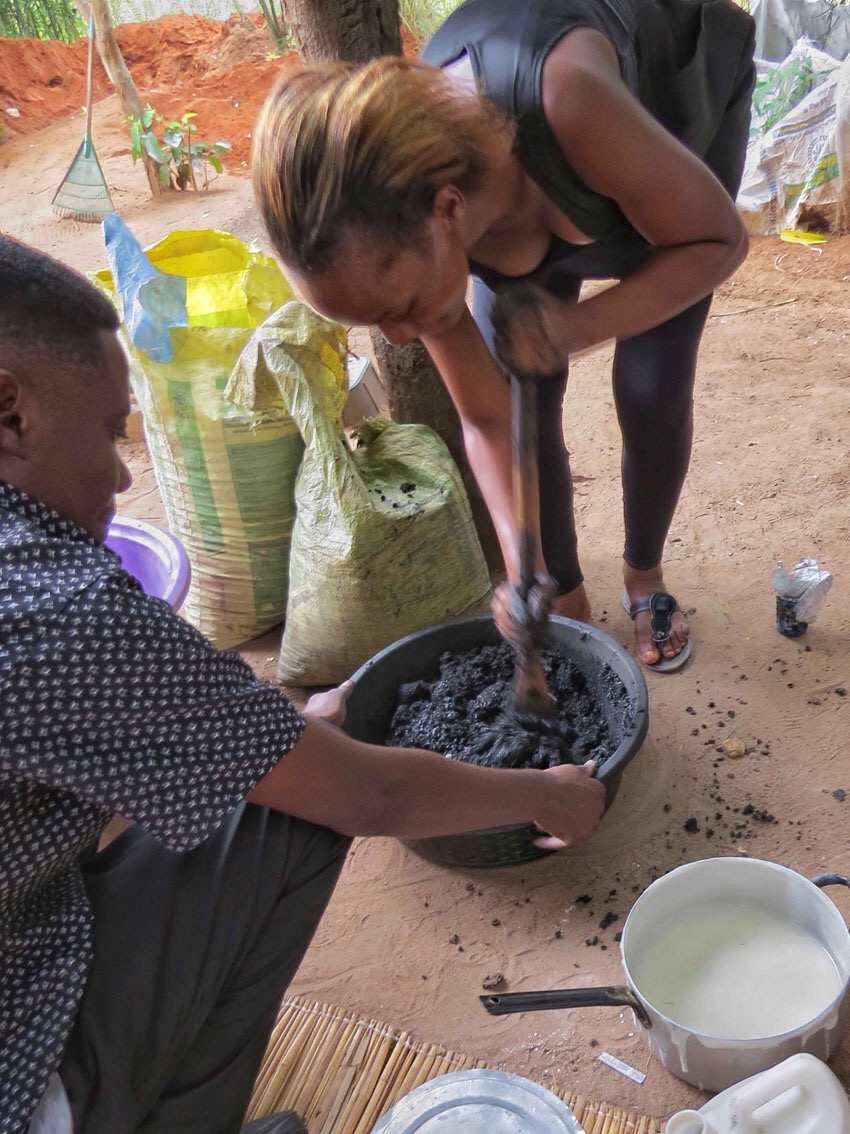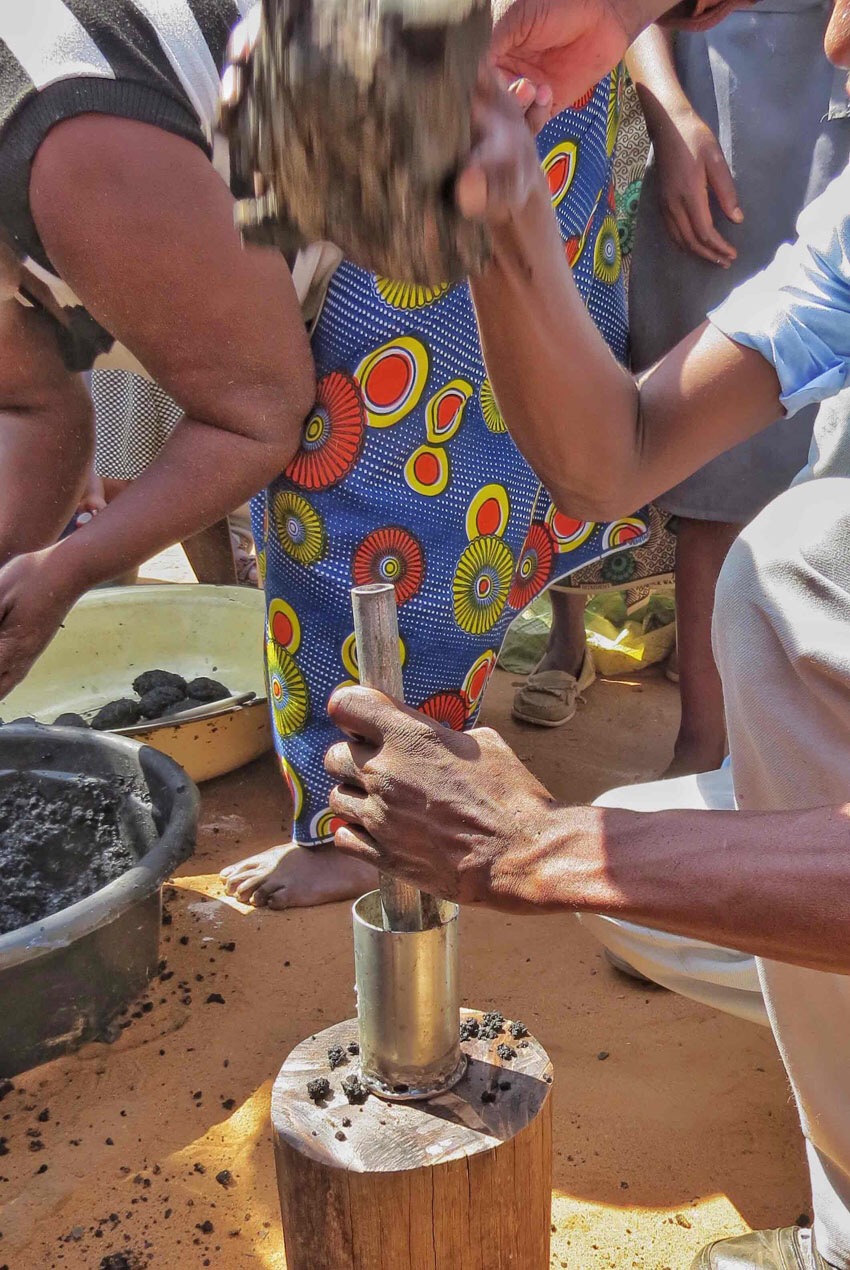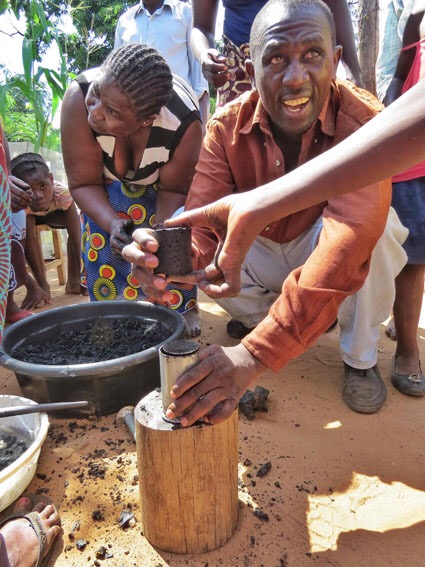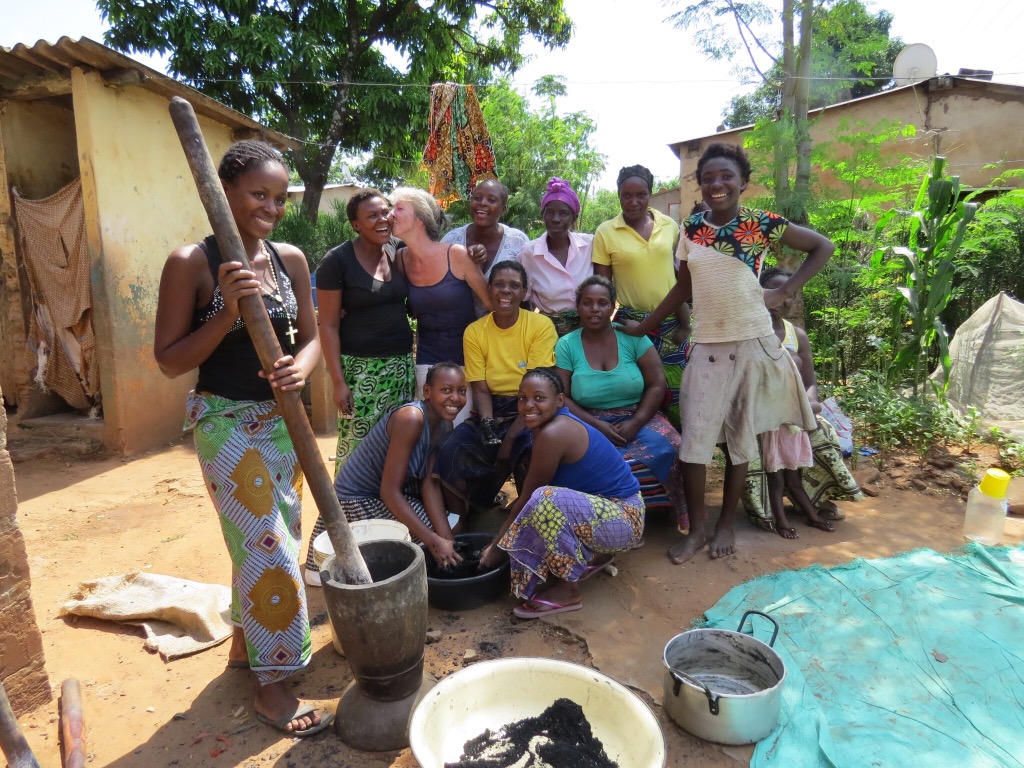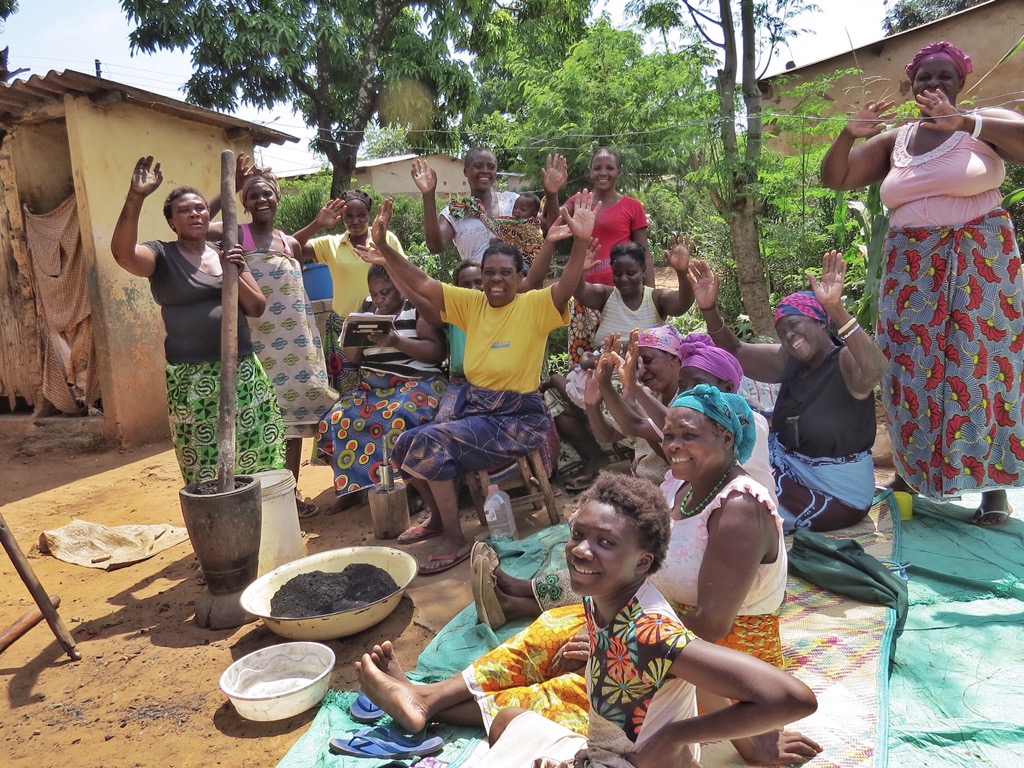There are few better ways to spend a couple of weeks in Zimbabwe than at Hwange. It’s hard to beat sitting around a waterhole with a cold Zambezi beer watching elephant, kudu, crocodiles, giraffe, impala, buffalo etc as they play out the daily ritual of grazing, hunting and looking for water.
A group of three young kudu hung around the camp for a while. They were very timid as the waterhole is quite exposed but I guess if every step could be your last, you’d be on your guard all the time as well.
Kudu have the most beautiful ears. They’re huge, relative to the size of their heads, and they constantly swivel them, seeking the sound of predators as they stay alert to every footfall or rustle they hear.
 The elephant on the other hand are content to throw their weight around and chase away anything that’s going to disturb their enjoyment of a quiet drink and a chance to paint themselves terracotta in the mud baths.
The elephant on the other hand are content to throw their weight around and chase away anything that’s going to disturb their enjoyment of a quiet drink and a chance to paint themselves terracotta in the mud baths.
 Perhaps the oddest thing we saw around the waterhole was a couple of mzungus out for a bush walk with a ranger. They arrived at the waterhole about 15 minutes after a 40+ herd of elephant left.
Perhaps the oddest thing we saw around the waterhole was a couple of mzungus out for a bush walk with a ranger. They arrived at the waterhole about 15 minutes after a 40+ herd of elephant left.
 I’m not sure how much luck the bush-walkers had spotting Game…
I’m not sure how much luck the bush-walkers had spotting Game…
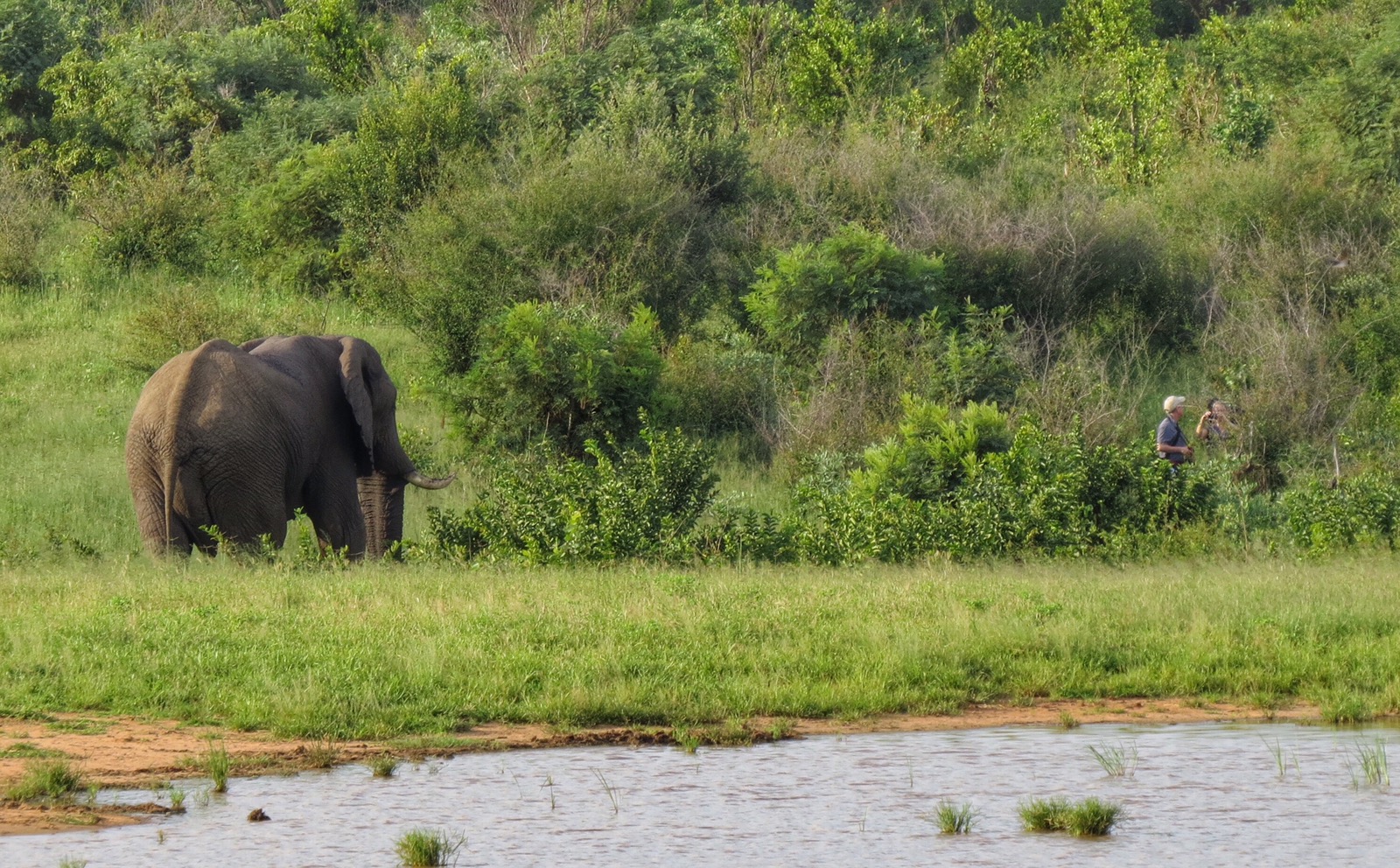 Looking a little bewildered, they wandered around the bush for about 30 minutes. I think they spotted the big bull elephant that shadowed them, but I’m not certain.
Looking a little bewildered, they wandered around the bush for about 30 minutes. I think they spotted the big bull elephant that shadowed them, but I’m not certain.
 We had a date with a couple of community groups back in Livingstone so, all too soon, we had to leave Ivory Lodge and head back to the Zambian side of the Zambezi.
We had a date with a couple of community groups back in Livingstone so, all too soon, we had to leave Ivory Lodge and head back to the Zambian side of the Zambezi.
Helene had promised Limpo and Febby (2 of the waitresses at Maramba River Lodge) that she would show them and the community leaders from each of their districts how to make Fuel Briquettes.
We weren’t sure how many people would show up at each of the sessions they had arranged, but had left them with instructions to collect as much charcoal dust as possible and round up the few simple pieces of equipment they would need.
When we arrived at Febby’s compound we were welcomed by about 40 local women, business people and Community Chairmen. I guess word had spread faster and further than we initially thought.
This was going to be a bit of a departure from our previous Fuel Briquette making in Uganda. We were focusing here on making them by hand or using a small, steel, single-piston mould rather than the large timber presses we had built for the Rwenzori Mountain groups. The timber presses cost about $150 each to assemble. This new-style steel, single-piston mould cost $5 for us to make 2 out of scrap metal.
We got stuck straight in and, at each community meeting, had a wonderfully enthusiastic and interested audience.
Everyone was keen to get hands-on as quickly as possible.
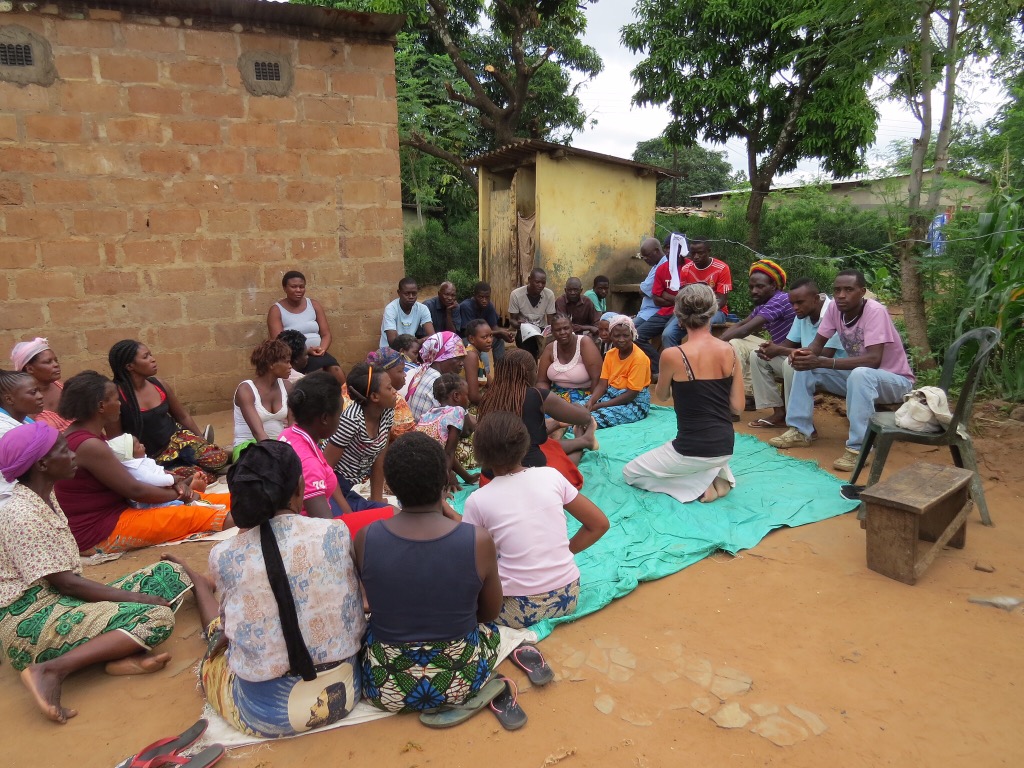 The process is essentially very simple – and cheap.
The process is essentially very simple – and cheap.
First, break up charcoal dust and small, unusable pieces of charcoal (‘charcoal fines‘) either by crushing it in a bag…
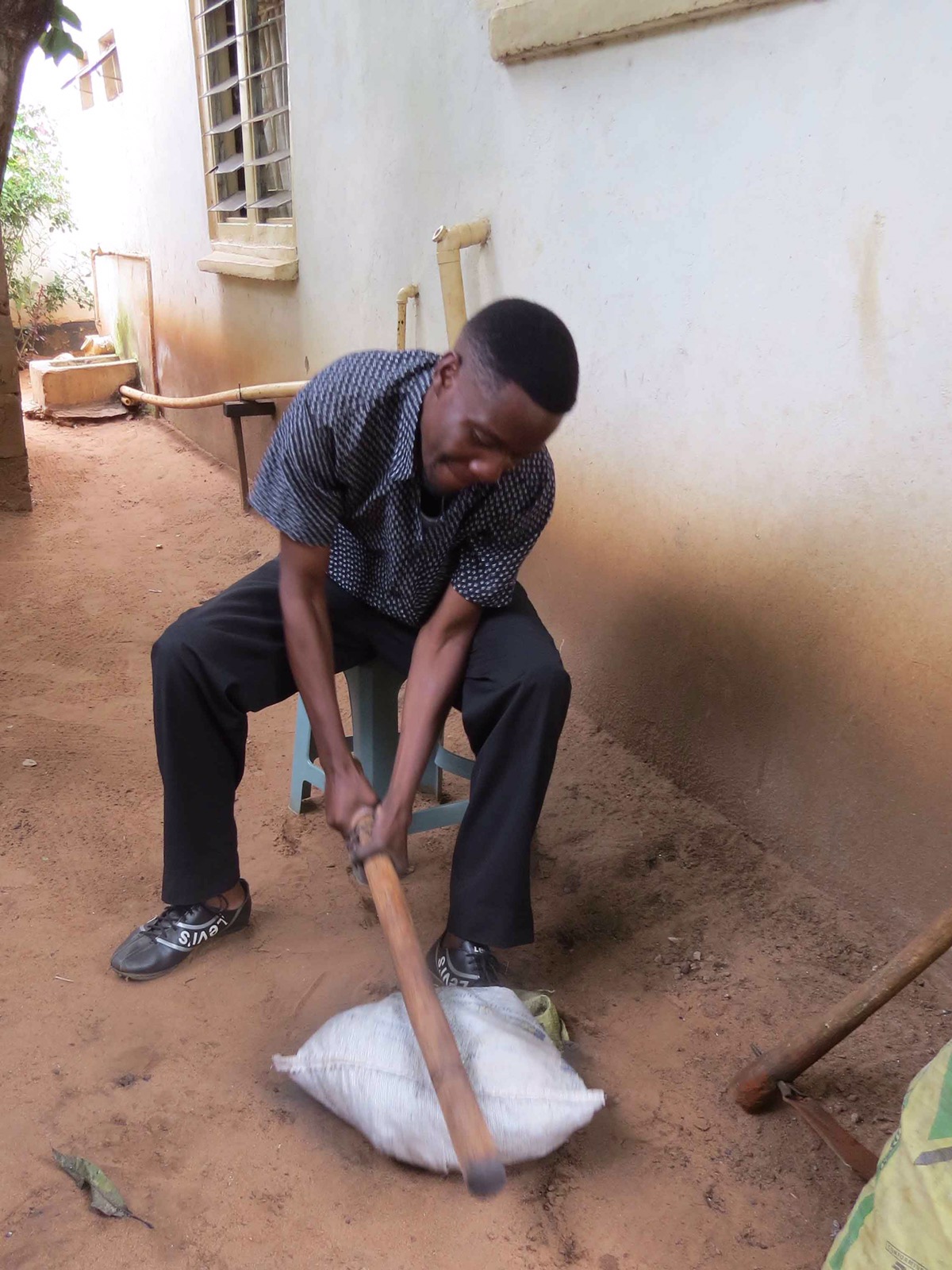 …or by pounding it in a pestle & mortar.
…or by pounding it in a pestle & mortar.
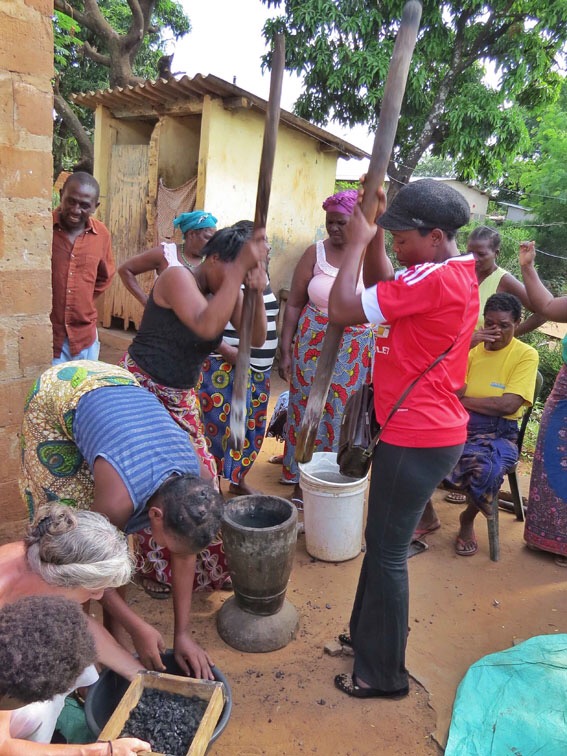 The ideal pieces of ‘fines’ to use for the briquettes are about the size of rice grains. Larger lumps can be removed with a simple sieve or by shaking the collection basin so that the largest pieces rise to the top.
The ideal pieces of ‘fines’ to use for the briquettes are about the size of rice grains. Larger lumps can be removed with a simple sieve or by shaking the collection basin so that the largest pieces rise to the top.
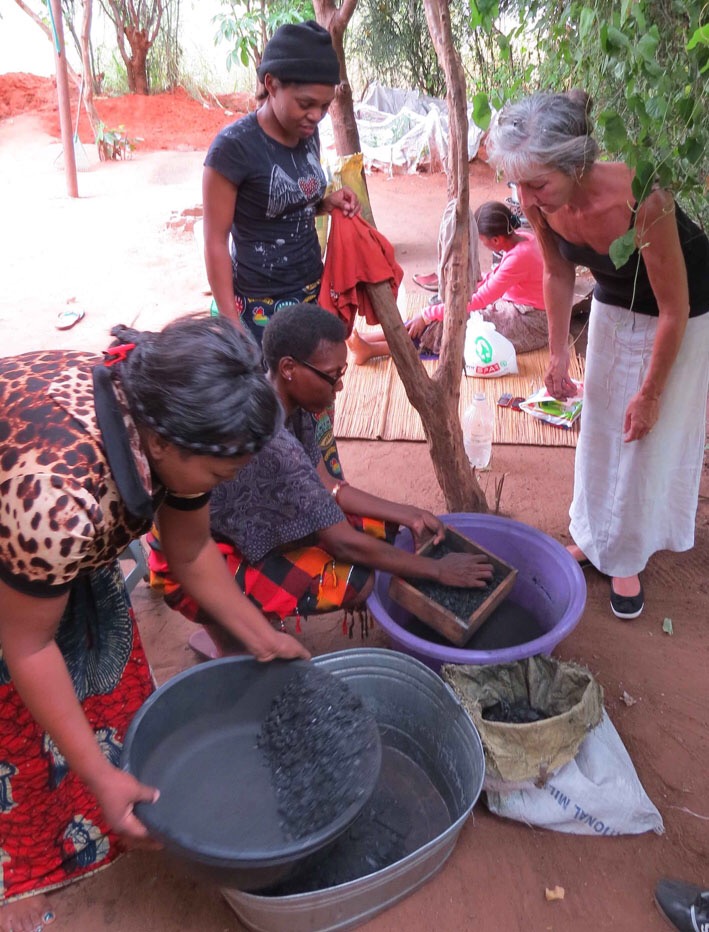 Quickly sort through the dust and fines to remove any bits of plastics (toxic when burnt) or pieces of glass / metal (could cause injuries when moulding & mixing by hand).
Quickly sort through the dust and fines to remove any bits of plastics (toxic when burnt) or pieces of glass / metal (could cause injuries when moulding & mixing by hand).
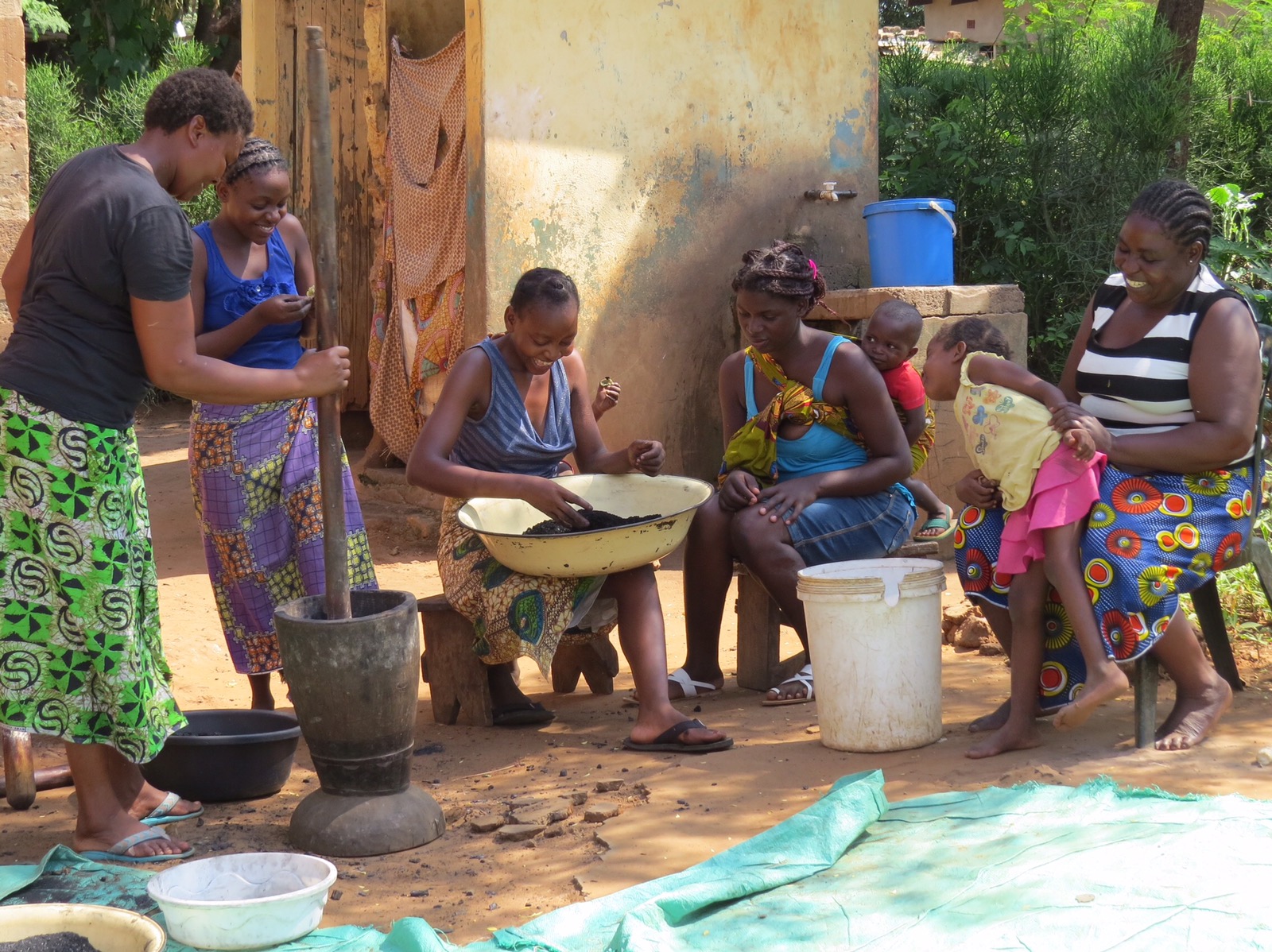 In the meantime, make up the porridge binder that will be used to set the briquettes into the finished shape. The binder is made like a porridge or nsima / pap / millie-meal (the staple diet of people in Eastern Africa). It is made by mixing either cassava or maize flour with cold water until it is dissolved into a paste…
In the meantime, make up the porridge binder that will be used to set the briquettes into the finished shape. The binder is made like a porridge or nsima / pap / millie-meal (the staple diet of people in Eastern Africa). It is made by mixing either cassava or maize flour with cold water until it is dissolved into a paste…
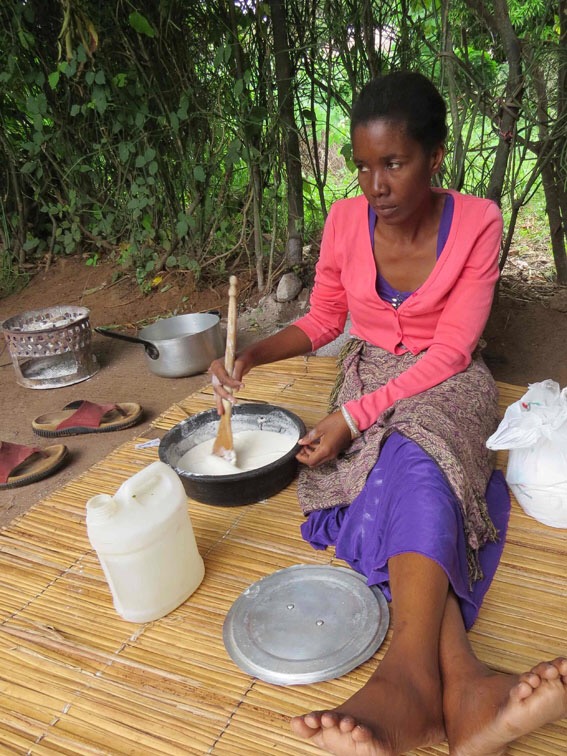 …then adding the paste to hot water…
…then adding the paste to hot water…
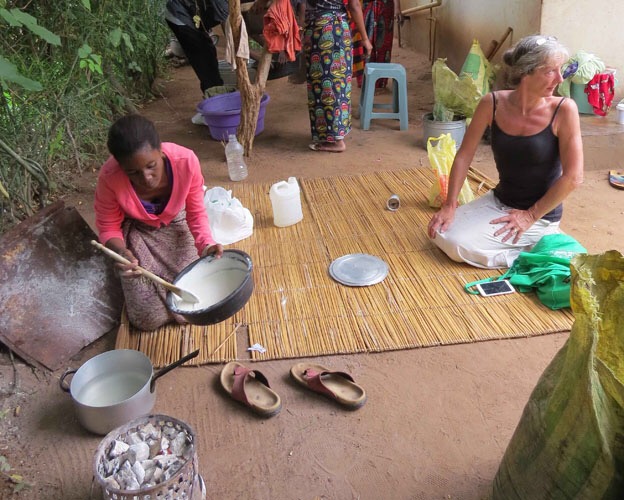 …and cooking / stirring it until it is the consistency of porridge. At this point it should be sticky to the touch if rubbed between your fingers (be careful, it’s hot!).
…and cooking / stirring it until it is the consistency of porridge. At this point it should be sticky to the touch if rubbed between your fingers (be careful, it’s hot!).
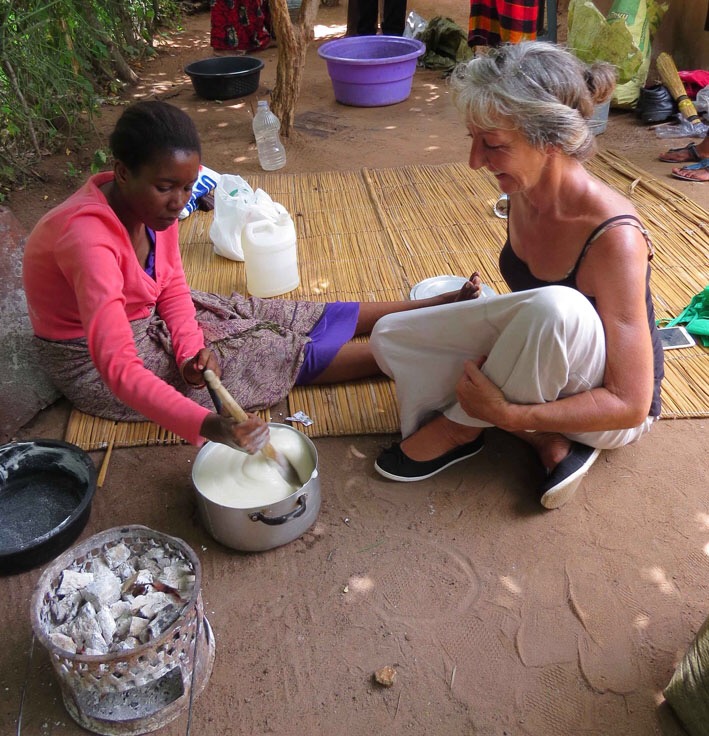 We have found that the best consistency for the binder is to use around 300g of flour to about 2.5 – 3 litres of water. If cassava or maize flour aren’t available, any starchy substance such as banana, plantain or potato could be used as an alternative binder (but it’s not as good).
We have found that the best consistency for the binder is to use around 300g of flour to about 2.5 – 3 litres of water. If cassava or maize flour aren’t available, any starchy substance such as banana, plantain or potato could be used as an alternative binder (but it’s not as good).
Before the porridge cools too much, pour some of it (maybe 30%) into a basin half filled with beaten charcoal fines…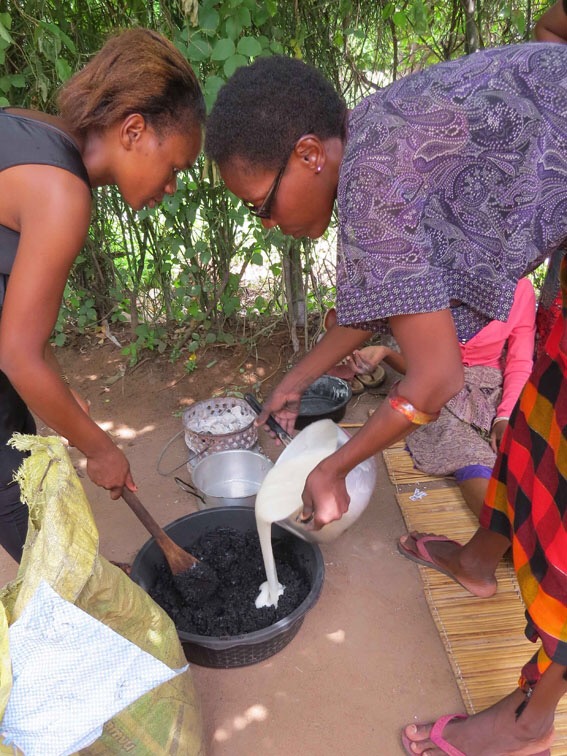 Mix the porridge into the charcoal with a spoon at first (the porridge is hot!).
Mix the porridge into the charcoal with a spoon at first (the porridge is hot!).
Then, as it cools slightly, get stuck in with your hands to ensure every bit is mixed thoroughly…
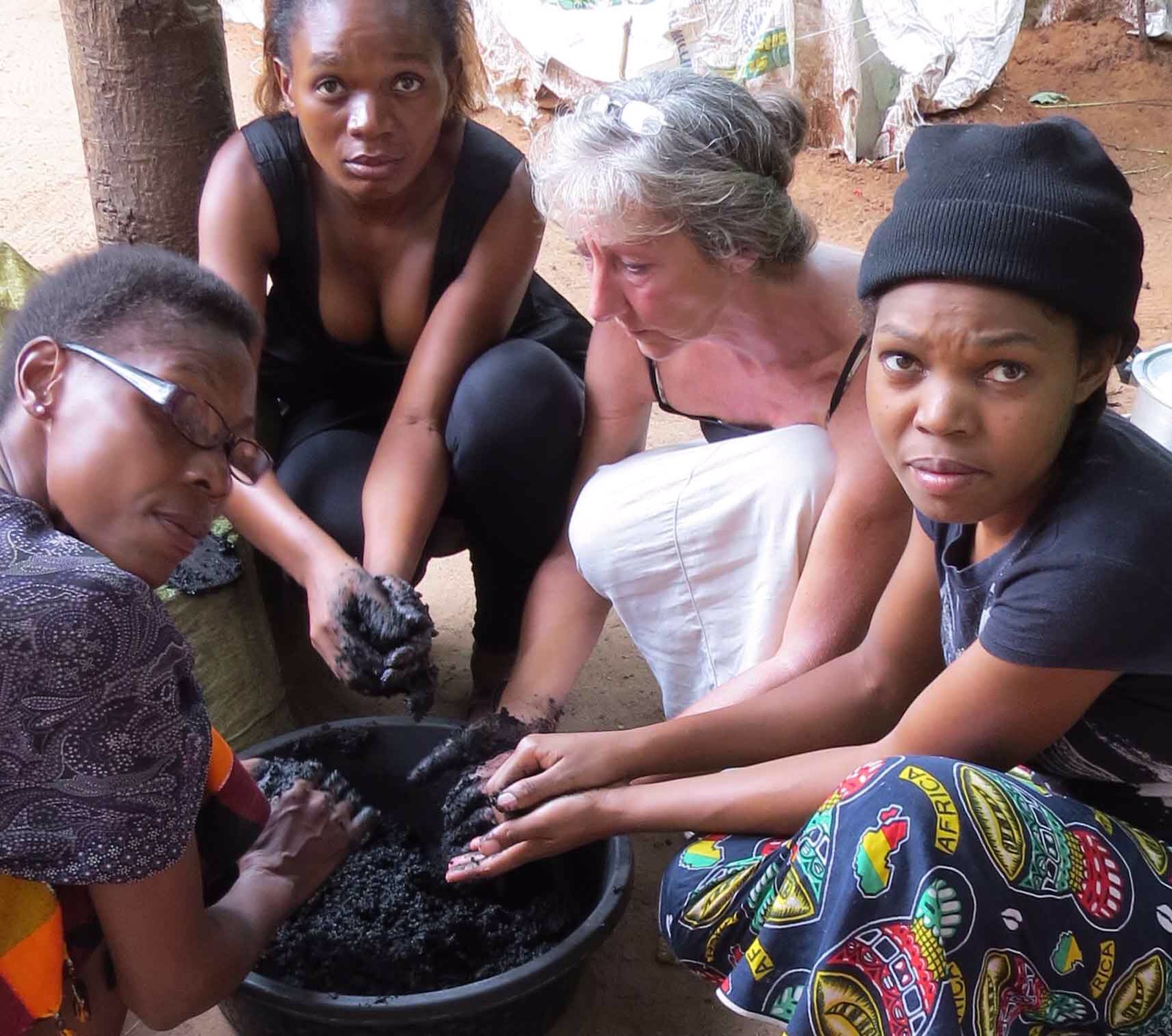 Feeling the mixture by hand is the best way to get to know the correct wetness and balance of porridge to charcoal.
Feeling the mixture by hand is the best way to get to know the correct wetness and balance of porridge to charcoal.
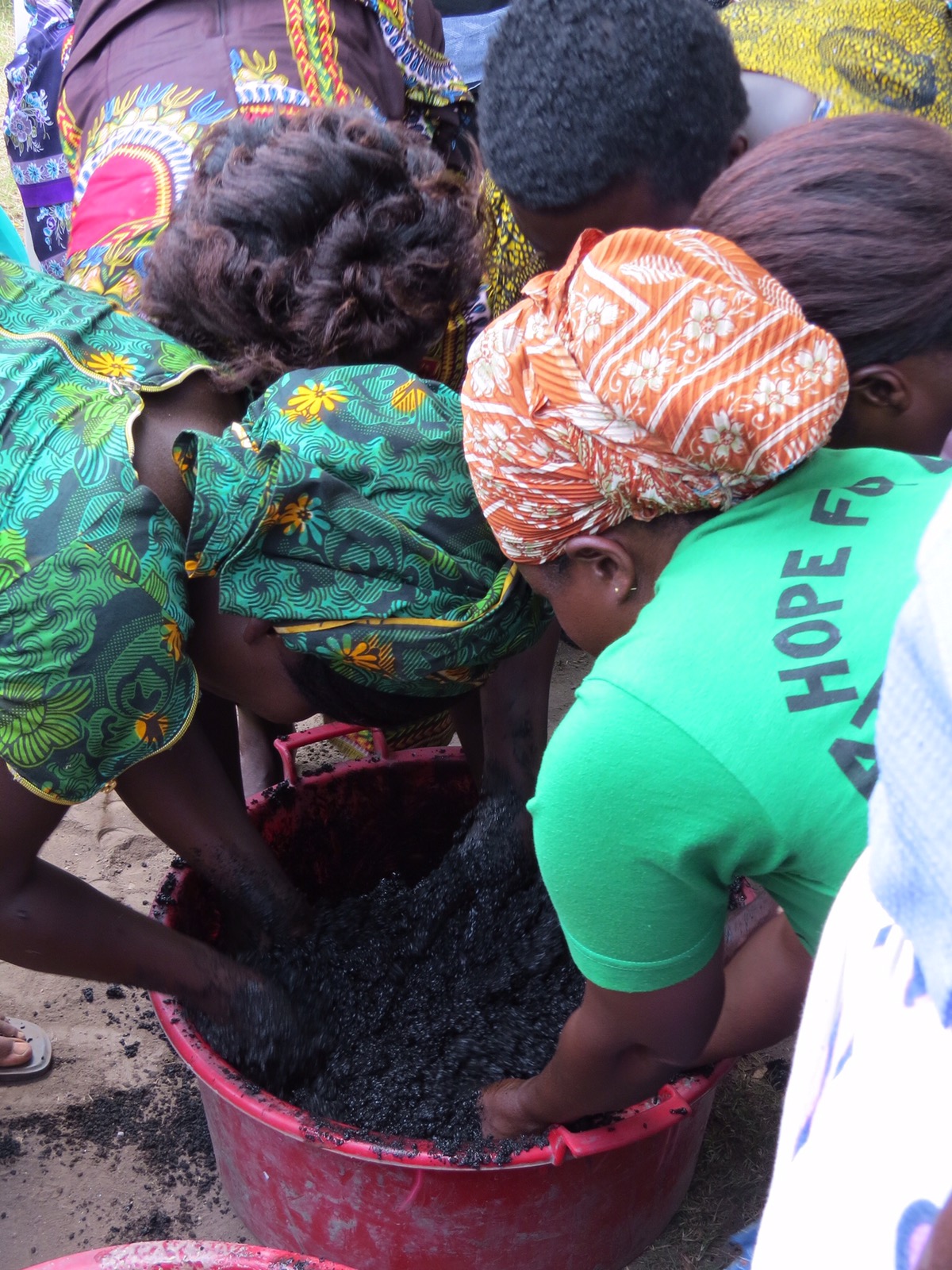 If the mixture is too dry a little more water can be added…
If the mixture is too dry a little more water can be added…
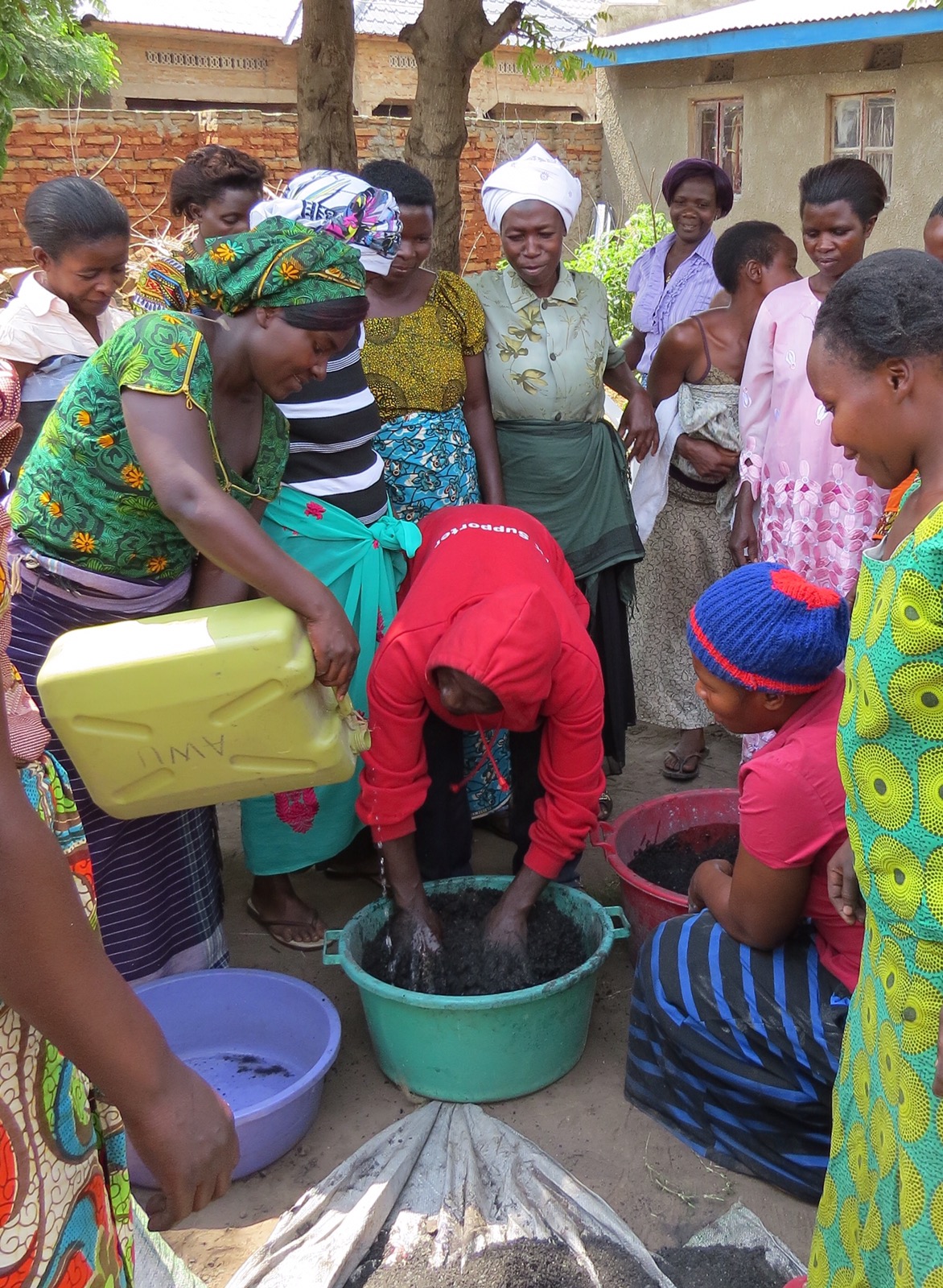 If it’s too wet, add more charcoal dust…
If it’s too wet, add more charcoal dust…
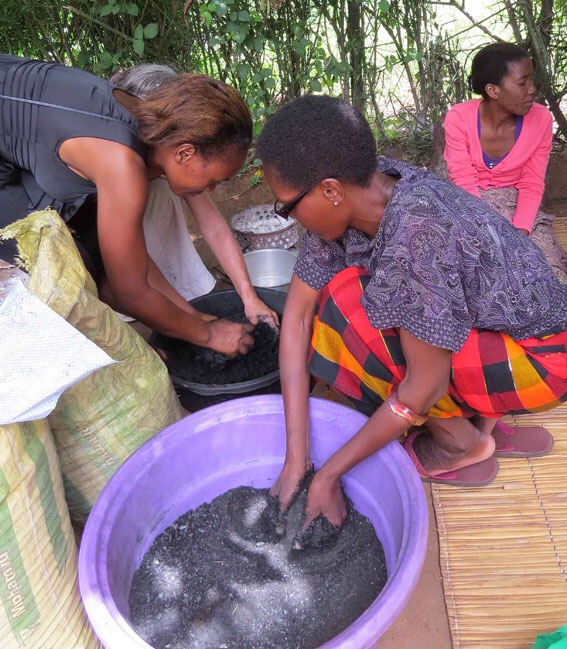 The ideal Fuel Briquette size is simply what can be moulded and compressed in the palm of your hand…
The ideal Fuel Briquette size is simply what can be moulded and compressed in the palm of your hand…
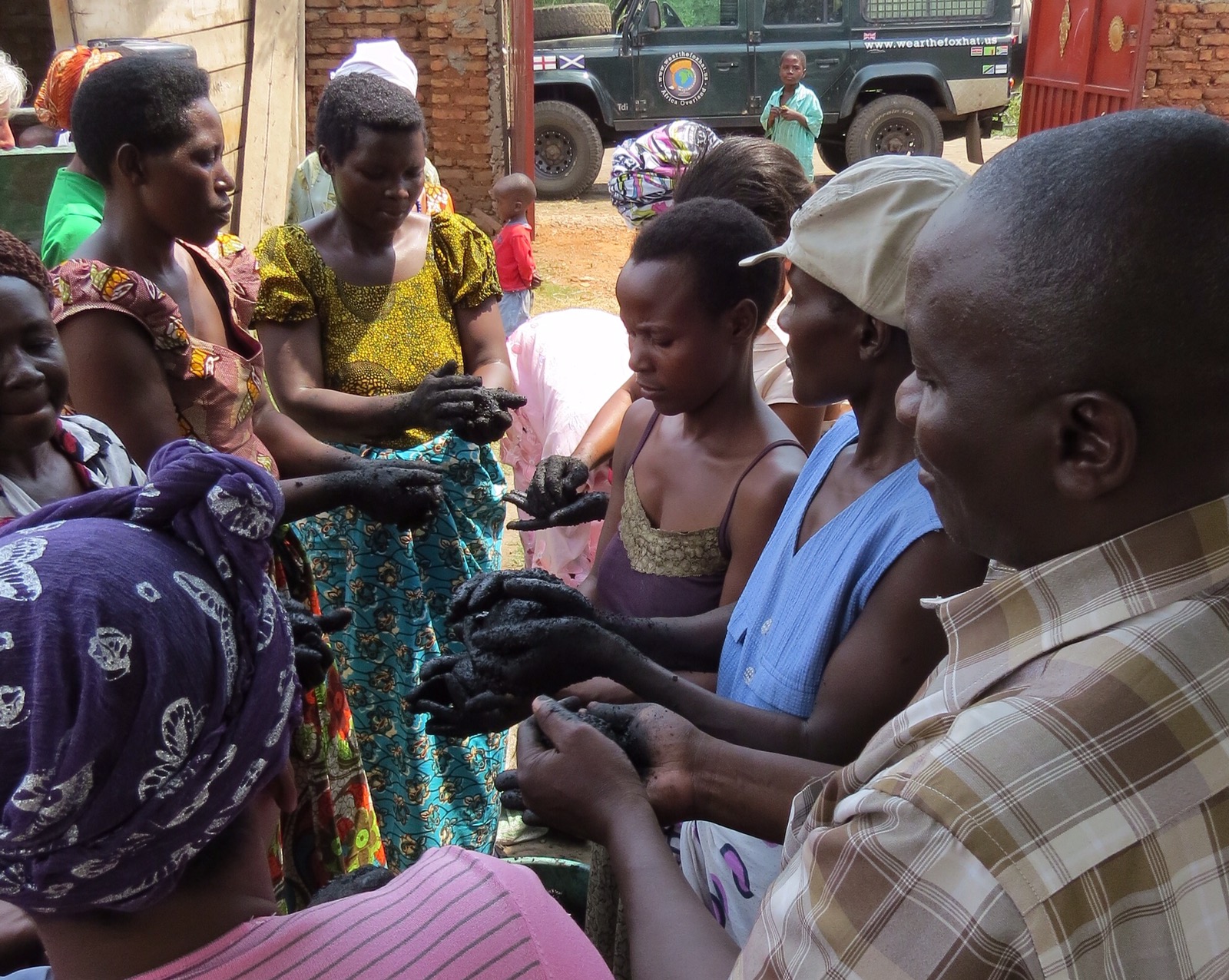 Once the briquette has been moulded, it must be handled with care as it is very fragile until it is dried.
Once the briquette has been moulded, it must be handled with care as it is very fragile until it is dried.
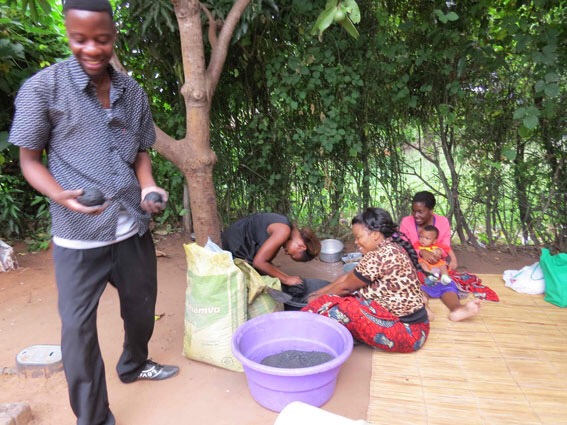 It will become much stronger as it dries over a 3-4 day period in a warm (but rain-sheltered) place. It is best not to have to move them and to lay them out either on a piece of sacking or an old metal sheet…
It will become much stronger as it dries over a 3-4 day period in a warm (but rain-sheltered) place. It is best not to have to move them and to lay them out either on a piece of sacking or an old metal sheet…
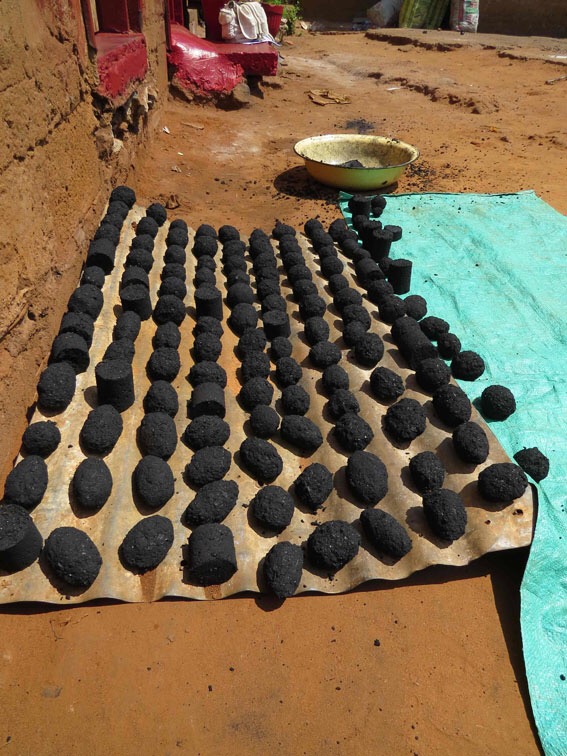 A simple steel piston-press is our favourite way to cheaply speed up the moulding process.
A simple steel piston-press is our favourite way to cheaply speed up the moulding process.
Makafute (one of the maintenance guys at Maramba River Lodge) made these presses for us for around $2 each from scrap steel pipe…
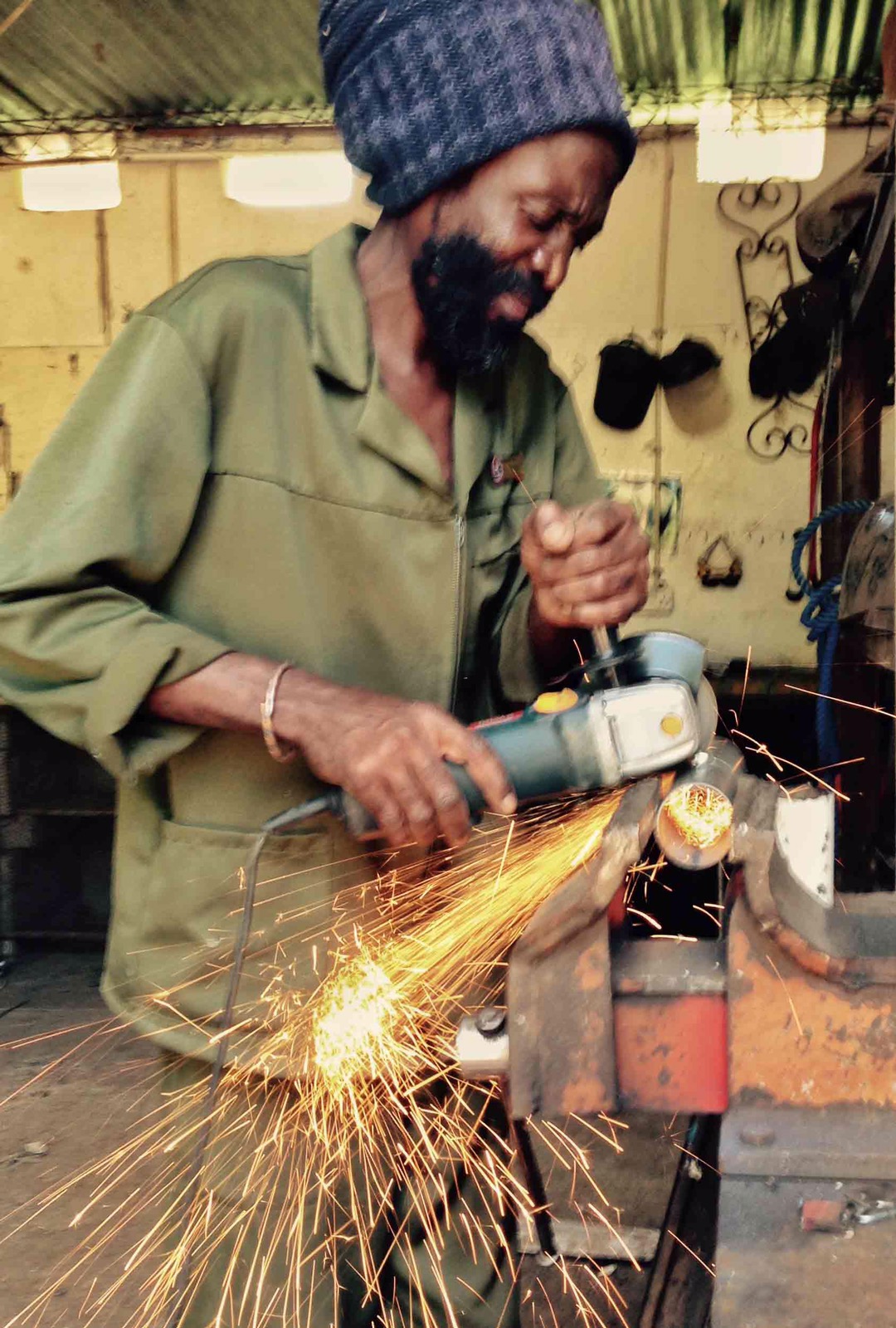 The pipe is left open at one end, but welded onto a base plate with a hole in it at the other end.
The pipe is left open at one end, but welded onto a base plate with a hole in it at the other end.
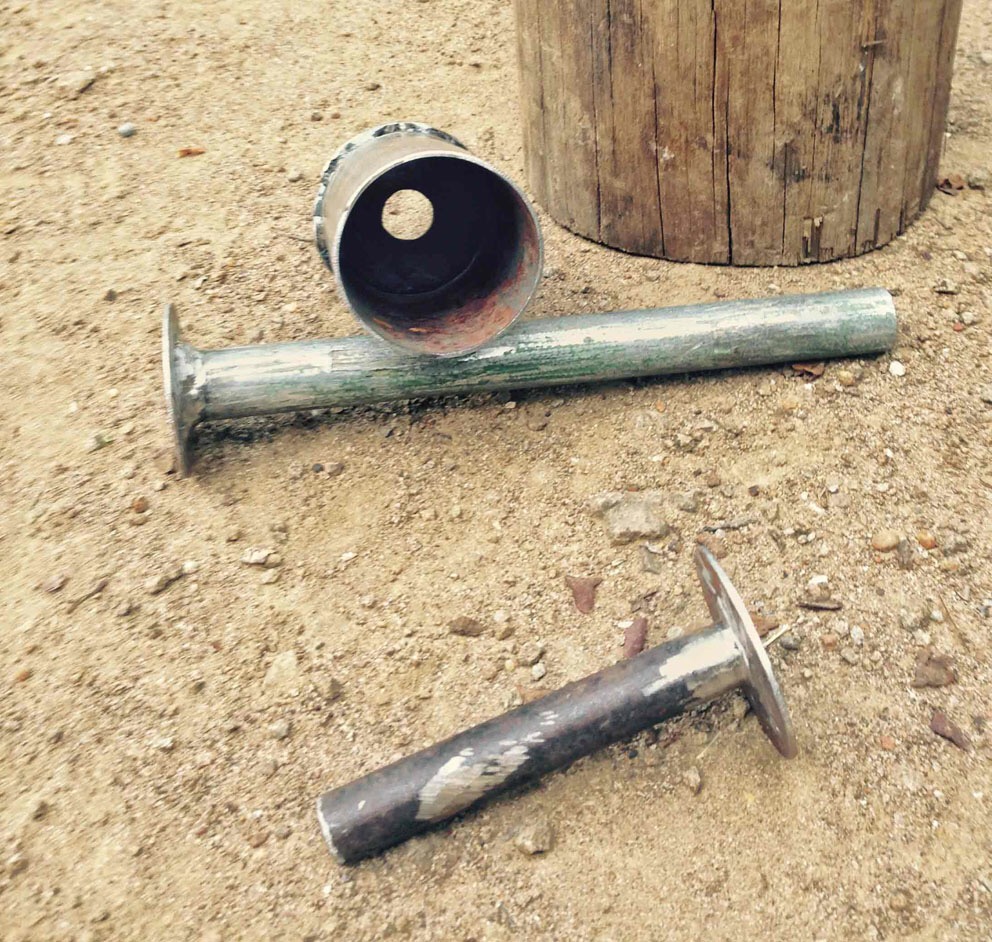 Two piston rods that fit inside the pipe are made from metal rods with a round plate welded onto one end of each. One rod will be used to compress the charcoal when the pipe is filled, the other rod is used to easily push the moulded briquette out of the pipe.
Two piston rods that fit inside the pipe are made from metal rods with a round plate welded onto one end of each. One rod will be used to compress the charcoal when the pipe is filled, the other rod is used to easily push the moulded briquette out of the pipe.
To use the single piston press, put the shorter rod through the hole in the base of the piston…
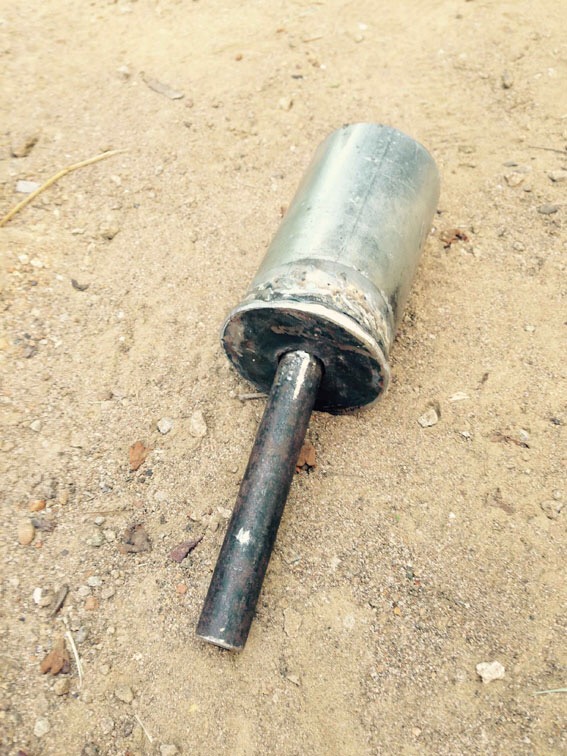 Scoop charcoal & porridge mix into the pipe until it is about 2/3 full.
Scoop charcoal & porridge mix into the pipe until it is about 2/3 full.
Put the piston onto the wooden block, with the bottom rod inside the hole that has been made in the top of the wood…
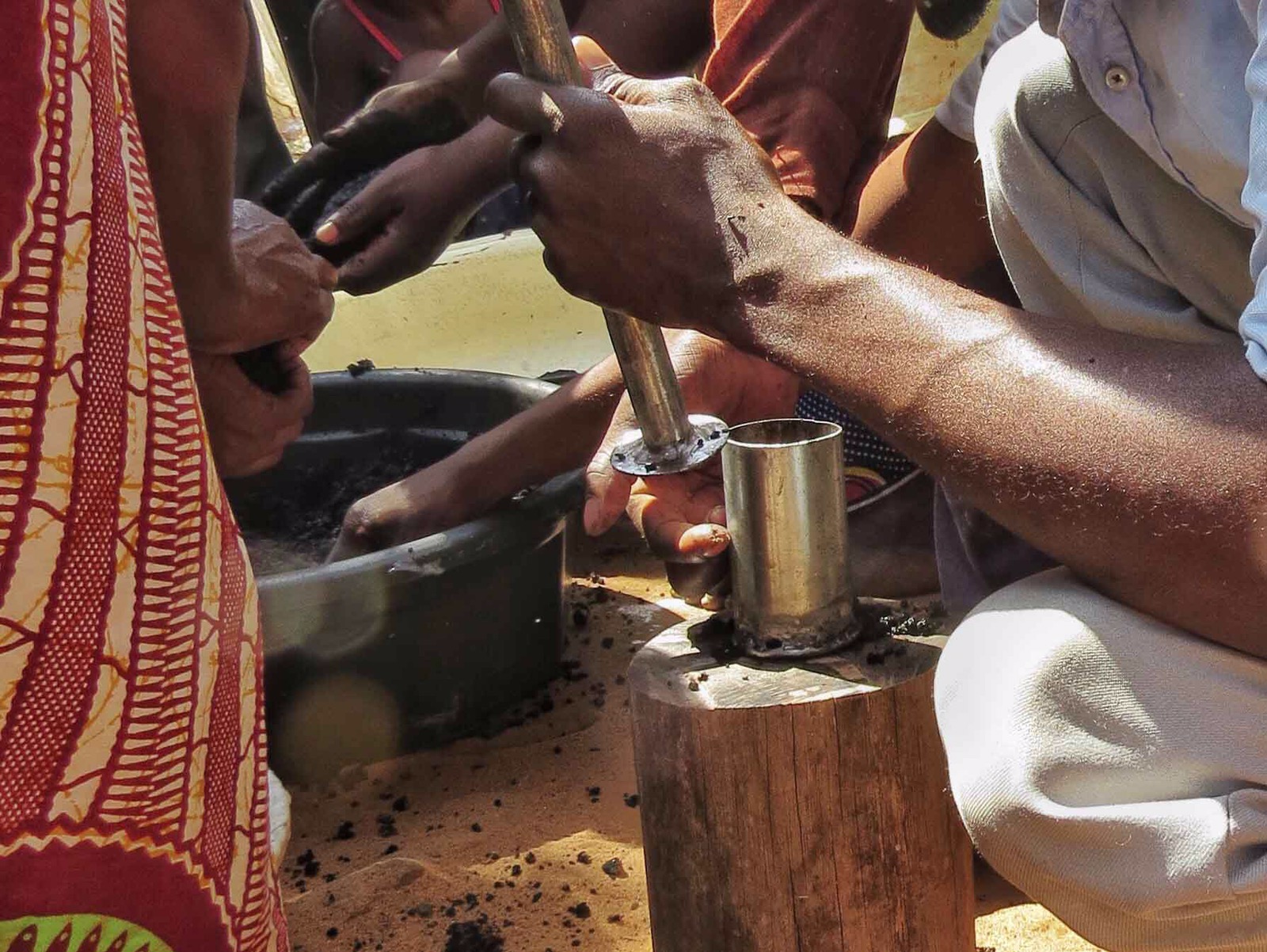 Put the flat plate of the 2nd, (longer) rod into the top of the pipe and hit it a couple of times with a hammer, stone or piece of wood.
Put the flat plate of the 2nd, (longer) rod into the top of the pipe and hit it a couple of times with a hammer, stone or piece of wood.
This compresses the charcoal and binder.
Lift the cylinder out of the hole in the wood block. Rest the bottom rod on the top of the wood block…
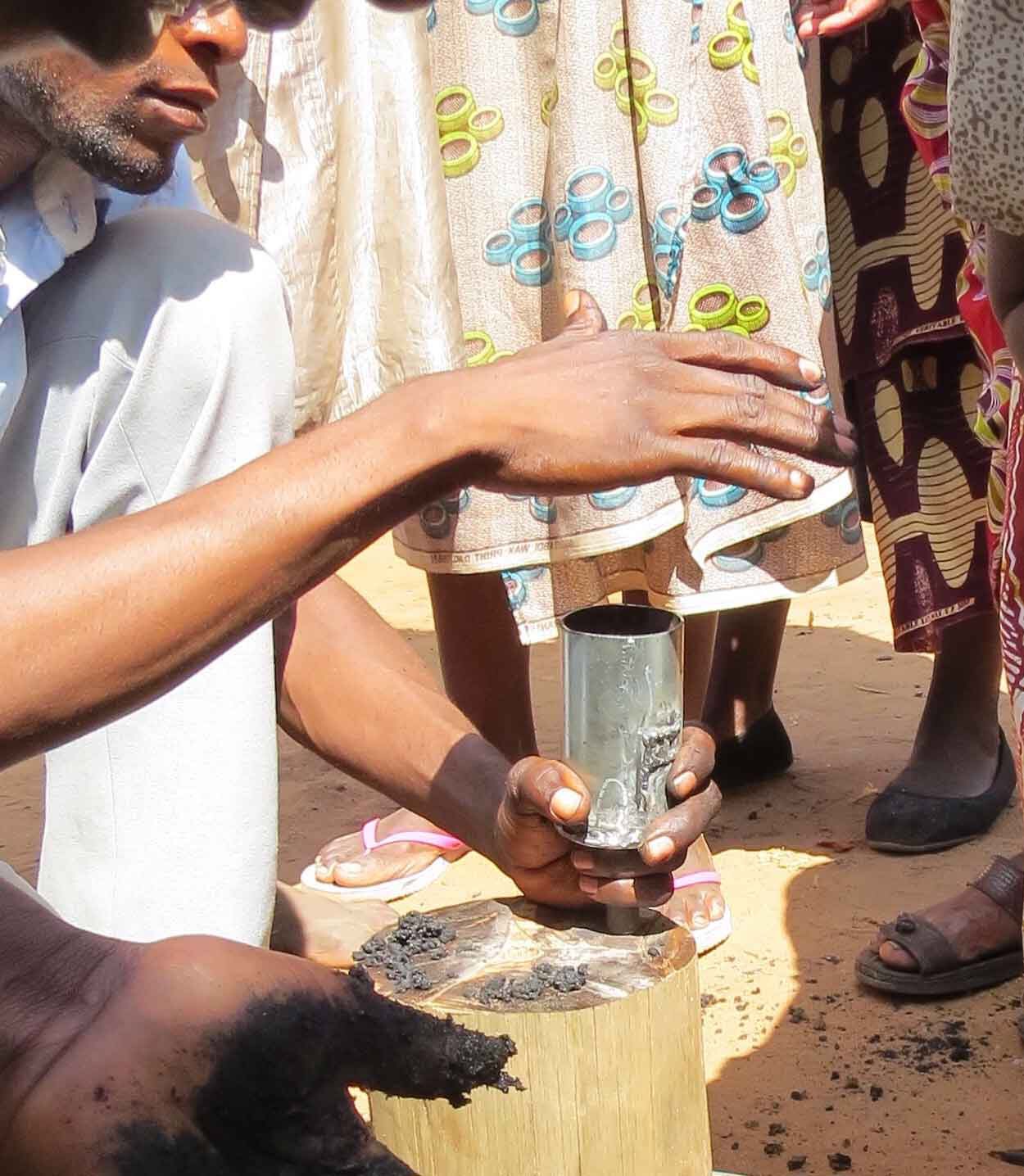 …and push down on the cylinder. The bottom rod will then carefully push a beautifully moulded briquette out of the top of the piston.
…and push down on the cylinder. The bottom rod will then carefully push a beautifully moulded briquette out of the top of the piston.
Voila!!
This type of simple press is cheap to make and simple to use. Our experience is that a group of 3 or 4 people grinding charcoal fines, mixing binder and moulding briquettes can make 600-1,000 Fuel Briquettes a day using this system. For free!
This is truly remarkable and can be life-changing. A sack of wood-charcoal for cooking costs the equivalent of 3-7 days’ wages. However, once thoroughly dried, 6-8 home-made Fuel Briquettes can be used to boil water for drinking and cook an evening meal for a family – including beans (notoriously the longest and most fuel-expensive food to cook).
At their first attempt, even given the chaos of teaching, learning , laughing, chatting and experimenting, this wonderful group made 280 Fuel Briquettes from a standing start in a 3-hour lesson!
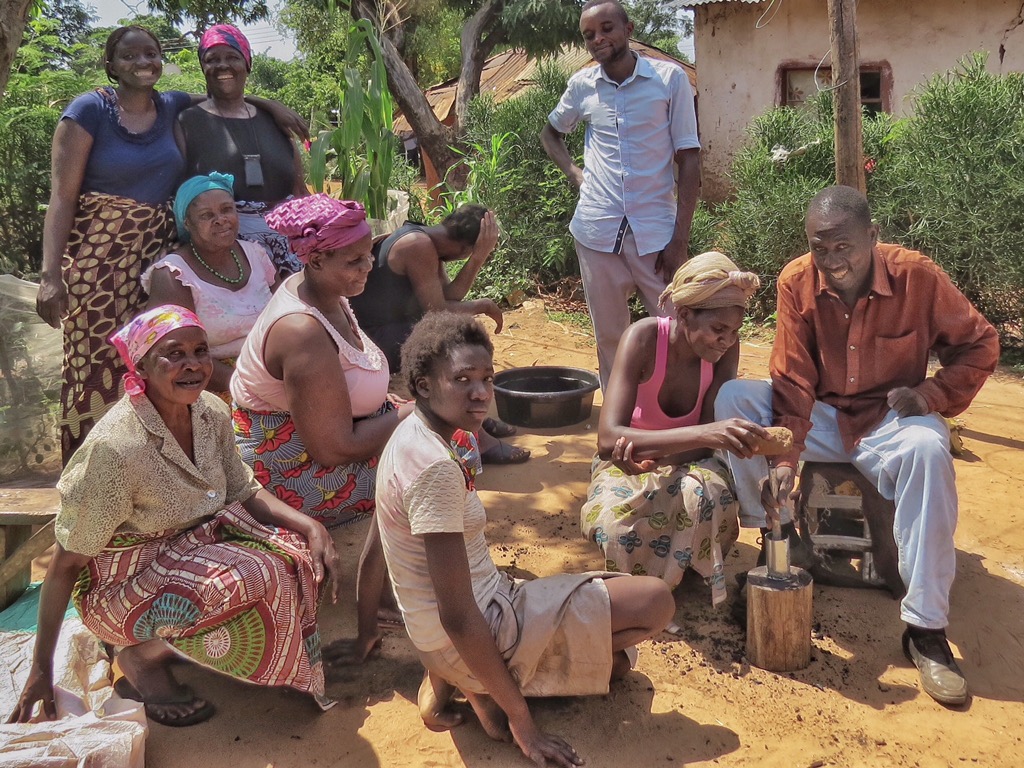 I don’t know who enjoyed it more, us or them.
I don’t know who enjoyed it more, us or them.
Top Tip:
We’re making up a small photo-manual which will show in detail how to make Fuel Briquettes, plus how to make your own charcoal from farm / agricultural waste and how to make mud rocket-stoves that will improve the efficiency of charcoal cooking fuel by about 50%. This will be available as a download PDF document on the ‘Community‘ tab of our website and on the AmahaWe Uganda website (amahaweuganda.org) in a few weeks.
In the meantime, if you want a copy, send an email to us at helene@amahaweuganda.org and we will forward the manual to you.


